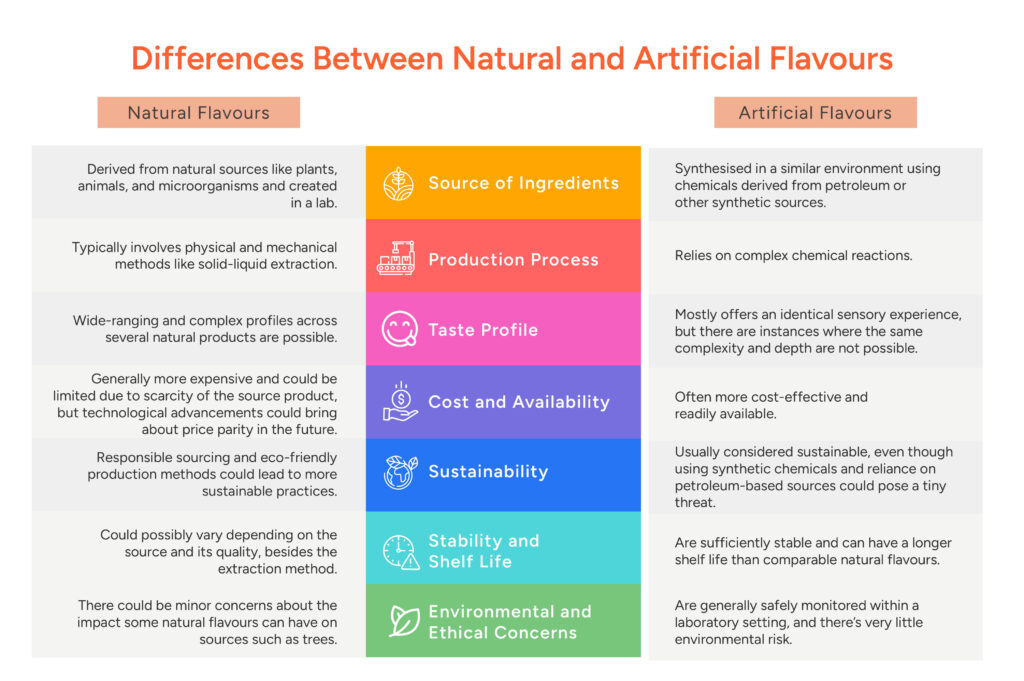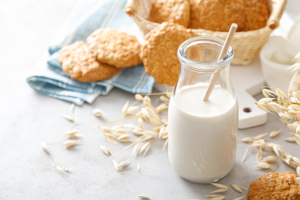What puts the ‘delicious’ in what we eat and drink? Flavour, of course. But it goes beyond what we taste or what makes us nod in appreciation after a bite of something special. Flavour defines the taste of food and drink, besides their texture and smell: It’s the complete sensory experience that encapsulates just how complex and rich food can be, whether it be the smooth sourness of a green apple candy or the pleasant sweetness of vanilla ice cream. Understanding the difference between taste and flavour is key, as taste refers to basic sensations like sweet, sour, salty, and bitter. In contrast, flavour is the combination of these tastes along with aroma and texture.
As far as flavours go for processed foods, there are two primary types. Some are created in a laboratory from scratch, and some are formulated in a laboratory, albeit possessing natural origins—a tree bark, a leaf, a plant root, or, in some cases, fauna. Over the years, the debate around natural vs artificial flavours has become fiercer as consumers have become more invested in the whole saga. While food manufacturers have their own reasons to choose between the two, it matters to consumers since knowing the difference could dictate how their buying habits evolve and how they approach products.
So, what exactly separates the two flavours? Do they taste different? Are artificial flavours bad? Is one costlier than the other? We cover all that, dissecting the subtle differences between natural and artificial flavours and helping you determine what works best for your products.
What Are Natural Flavours?
The term ‘natural flavour’ broadly refers to products containing the flavouring constituents obtained from vegetables, fruits, spices, and other organic materials like animals. They can include juices, herbs, tree bark, roots, dairy products, and eggs and can also result from microbial fermentation. Various regions can have their own definition of what a natural flavour is—the FDA in the USA, for one, refers to it as ‘the essential oil, oleoresin, essence or extractive, protein hydrolysate, distillate, or any product of roasting, heating or enzymolysis’ containing flavour constituents derived from various natural sources.
These flavours are often obtained from fruits by expression. Another standard method is extraction, which includes distillation, chromatographic separation, solvent extraction, and pressing. Some well-known examples are turmeric, ginger, orange essence, and annatto extract.
What Are Artificial Flavours?
An artificial flavour is a substance created from chemical sources, even if they share the same chemical composition as flavours with a natural origin. They are merely chemical expressions of various foods, synthesised to mimic or come close to the natural products they are based on. They are formed by bringing various synthetic flavouring agents into a solution with alcohol, glycerol, or propylene glycol. The grape flavour in zesty drinks? It’s probably methyl anthranilate. And the burst of orange in various ready-to-eat cakes might be down to ketone D. While these are some examples, certainly, vanilla-flavoured products come entirely from vanillin.
Differences Between Natural and Artificial Flavours

Source of Ingredients
Natural flavours are derived from natural sources like plants, animals, and microorganisms (either in the raw state or after processing by traditional food preparation processes) and created in a lab. Artificial flavours are synthesised in a similar environment using chemicals derived from petroleum or other synthetic sources.
Production Process
Natural flavours are typically produced by physical and mechanical methods like solid-liquid extraction. Artificial ones rely on complex chemical reactions carried out in a lab and undergo rigorous testing, quality control, and changes.
Taste Profile
Wide-ranging and complex profiles across several natural products are possible. For the most part, artificial flavours offer an identical sensory experience, but there are instances where the same complexity and depth are not possible.
Cost and Availability
While natural flavours are generally more expensive and could be limited due to scarcity of the source product, technological advancements could bring about price parity in the future. Synthetic options are readily available and often more cost-effective.
Sustainability
Even as their perceived health benefits make them appealing to health-conscious consumers, the overall sustainability of natural flavours depends on the production processes involved and their ecological impact. Responsible sourcing and eco-friendly production methods could lead to more sustainable practices. Artificial flavours are usually considered sustainable, even though synthetic chemicals and reliance on petroleum-based sources could pose an environmental threat.
Regulatory Standards
Regulatory bodies in their respective regions lay out strict regulations governing artificial and natural flavours. All approved flavours are monitored continuously and evaluated from a health perspective, and besides permitting their usage, these regulations also lay out criteria that define natural flavours. The same level of scrutiny and regulatory oversight exist for both flavours. In fact, the FDA states that ‘food ingredients must meet the same safety standard regardless of whether they are naturally or artificially derived’.
Stability and Shelf Life
Depending on the source and extraction method, natural ingredients could degrade over time, causing issues with taste and texture. However, ingredient providers are innovating to create more stable types. Artificial flavours have an advantage here as they are more stable and can have a longer shelf life than comparable natural flavours.
Environmental and Ethical Concerns
There could be minor concerns about the impact of some natural flavours on sources such as trees. For example, the indiscriminate use of a specific plant species to obtain a flavour could threaten their availability and raise ethical concerns. Since artificial flavours are monitored in a laboratory setting, they are generally safe, and there’s very little environmental risk.
Impact of Natural and Artificial Flavours
A few details aside, both artificial and natural flavours are practically indistinguishable. They’re basically similar, made of the same flavour molecules. Nutritionally, there’s no difference, either.
This begs the question: What should manufacturers be looking at? If cost is an issue, artificial flavours are a better option. They’re easy to procure and are always available. However, changing consumer preferences, driven by emerging flavour trends, could nullify these flavours’ price advantage.. People are increasingly mindful of what goes into what they consume, and there is a consensus that ‘artificial’ isn’t good for health. (It probably conjures up images of chemicals being whisked in a beaker and fumes emitting from test tubes.) Despite both flavours arising in the same environment, the negative association is far too overwhelming. Simultaneously, in a more literal sense, consumers’ tastes are also evolving as they seek more adventurous flavours. In a delicate dance, flavour scientists will need to balance health concerns and taste demands to find ways to market flavours that appeal to the public while meeting business needs.
Most importantly, manufacturers should remember to keep an eye on regulatory standards for flavours in their respective territories. Despite murkiness in some parts over labelling, these guidelines ensure transparency and that consumers aren’t misled by false claims. Regulations push products to meet various criteria and assure consumers of safety. Working in accordance with them is essential, regardless of the choice of flavour.
What’s Your Flavour?

Knowing how natural and artificial flavours differ can empower manufacturers to make better decisions. While the differences mostly have to do with production and the logistics involved, the end results are often of comparable quality. Manufacturers should thus assess their capabilities and requirements, besides factoring in consumer sentiment, to decide what works best for them.
And thanks to innovation, there is a case for natural flavours, such as Symega’s range of natural flavours, that are technologically advanced and robust enough to meet the most demanding of expectations. As time passes, the ‘natural vs artificial flavours’ debate could be settled soon. Until then, choose wisely! If you’re still unsure, get in touch. We’ll figure it out for you.
FAQs
From a consumer health perspective, there’s not much of a difference. Both flavours are assessed strictly by regulatory bodies in different markets and meet various criteria. Chemically, there’s not much to separate the two. Natural flavours obtained from plants like turmeric and black pepper come from sources we consume regularly—but they’re still made in a lab. Now, artificial flavours are not recommended in large amounts, but approved flavours are generally safe. For manufacturers, the choice comes down to what flavour offers value for their products. This should be decided by keeping costs, food trends, and target customer and consumer perspectives in mind.
There could be different factors to consider. Sometimes, a flavour’s natural source might not be readily available due to difficulty procuring it or scarcity. If this is the case, companies must find a way to mimic the flavour and synthesise it. This can help cut costs and still meet consumers’ expectations and market demand. Additionally, the processes involved in creating artificial flavours can lead to unique or novel flavours that may not exist in nature. There’s also the issue of consistency to consider—natural flavours could be affected by environmental conditions and processing methods. Artificial flavours are unaffected by this concern, which is a huge draw for manufacturers. As a result, these flavours are versatile and are used extensively across foods and beverages.
Artificial flavours do a good job of capturing several basic natural ingredients. But they can struggle to replicate the depth and complexity found in some plants and animals that could have hundreds of flavour compounds. It can be challenging to figure out the exact chemical composition in some instances or find an adequate laboratory compound to match the molecular fingerprint of the source. Flavourists end up having to approximate their products or find a workaround. These constraints are why some artificial flavours seem off, managing to convey the primary notes but giving off an unnatural feel that diminishes the overall sensory experience.
Checking the product label is the easiest way to know the flavour used. Regulations might vary across regions, but some standards insist that the use of artificial flavours is mentioned clearly. In the USA, products whose flavours come from artificial sources must be labelled as such. The EU differs in that artificial flavours are labelled more generically (for example, mint flavouring or simply flavouring). But this might be of little use when one natural flavouring and one synthetic flavouring are involved—the label could just state flavourings here. Reading the ingredients list and making a deduction is as good an option as any in these cases.
While most artificial flavours can mimic the flavours of various natural sources accurately, and consumers can barely tell the difference, there are some instances where natural flavours could outperform their synthetic counterparts on the taste test. Some artificial flavours cannot be synthesised perfectly in a laboratory, yielding flavours that pale next to the ‘real’ thing.




